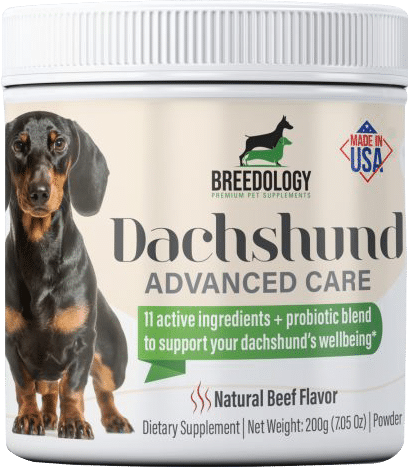When it comes to accessing information about the health of your dog, the term Acanthosis Nigricans in Dogs may be something you’ve heard mentioned a few times.
Acanthosis Nigricans in dogs is a clinical term used to refer to a dog’s problematic skin condition.
A common health issue, it’s undoubtedly the one that is worth looking into further. It is especially so if you’re a dog owner, and your chosen dog type is a dachshund breed.
This article offers a clear definition of the term Acanthosis Nigricans (Hyperpigmentation) in Dogs. It also describes its clinical signs and causes and the appearance of this condition in the dachshund breed.
As well as that, the article highlights the treatment and management of hyperpigmentation in dogs.
What is Acanthosis Nigricans in Dogs?
In short, Acanthosis Nigricans (Hyperpigmentation) in Dogs is a reaction of a dog’s body to certain conditions. Its presence affects the skin with the effects showing through its darkening and thickening.
When explored further, there are two forms of the term, primary and secondary.
Primary Acanthosis Nigricanis form in dogs is not curable, with Secondary Acanthosis form of the condition being treatable once the initial causes have been discovered.
Acanthosis Nigricans in Dogs: Clinical Signs and Causes
Acanthosis Nigricans (Hyperpigmentation) in Dogs isn’t that difficult to visually spot in canines. Experts suggest that the signs are more visible in the older dogs.

Therefore, once the signs are evident, a diagnosis can be made.
Clinical signs of Acanthosis Nigricans in dogs
The usual signs of this condition include:
- Bold patches of the skin
- Rougher areas of skin
- Thickened areas of skin
- Velvety to the touch areas of skin
- Visible light brown to black areas
- Affected areas usually confined to the leg and groin area
However, if the dog has an infection as well, other signs may include:
- Red, inflamed edges of the skin
- Variable itching
- Spreading of the condition gradually to most parts of the body
By the signs mentioned above, the veterinarians can determine the condition. Still, the causes of such symptoms will need to be considered before the vet can give a full diagnosis.
It is because some forms of hyperpigmentation in dogs can be relatively common and occur in a vast number of breeds.
However, if an infection is present and the hyperpigmentation starts to spread visibly, this could indicate the result of an underlying disease or a possible secondary infection.
For this reason, veterinarians will want to eliminate all possibilities of complications.
Primary hyperpigmentation is not curable and is merely a cosmetic issue, which doesn’t need treatment. Nevertheless, the presence of secondary hyperpigmentation will have to be treated to encourage the dog’s skin to return to the normal state.
Causes of hyperpigmentation in dogs
Though many issues are said to play a part in the appearance of hyperpigmentation (acanthosis nigricans) in dogs, some of the most common include:
Hypothyroidism
This is a thyroid disfunction which dogs experience commonly and results in many coat problems such as shedding, scaling, dullness, loss, or thinning. It also creates itchy skin infections and can show itself a constant lack of energy.
Lupus
This is an immune disease where the immune system itself attacks the dog’s healthy cells and tissues.
Allergies
Allergies might also cause acanthosis nigricans in dogs. Similar to those experienced by humans, allergies in dogs are numerous and include skin, eyes, and nose irritants.
Cushing’s Disease
This is an endocrine disorder where a dog’s body produces an excess of cortisol, which is the steroid hormone. The hormone then affects the kidneys.
This disorder can lead to many physical changes and, indeed, internal and mental issues – especially as the cortisol hormone is linked to stress levels.
Yeast infections
Yeast infections might be another cause of acanthosis nigricans in dogs. These are caused by fungus and are common skin diseases that many dogs experience. These infections typically show themselves as inflammations on the skin and dermatitis.
Acanthosis Nigricans in Dachshunds

Unfortunately, Acanthosis Nigricans (Hyperpigmentation) is most common in the dachshund breed, especially in shorthaired dachshunds.
One of the main reasons for this is that dachshunds are prone to hypothyroidism. Low thyroid function is one of the most common conditions present when diagnosing hyperpigmentation in dogs, in general!
Hypothyroidism is a thyroid hormone dysfunction that affects a dachshund’s coast, weight, activity levels, and immune system.
It also makes weiner dogs more receptive to skin infections, hair loss, and a dry, scaly, and itchy coat.
Therefore, when it comes to hyperpigmentation, dachshunds are the more likely breed type to experience this condition due to their already underlying issues with hypothyroidism.
My Dog’s Skin Is Turning Black: Is It Acanthosis Nigricans?
One thing to remember is that one of the symptoms of Acanthosis Nigricans in Dogs can include witnessing the dog’s skin turning black.
Therefore, it’s vital to have your dog checked to make sure the actual diagnosis is that of hyperpigmentation and nothing sinister.
The check at the vet is to purely rule out any other possibilities, such as sarcoptic mange, mites, or other infections that will need to be treated separately.
Yet, with the presence of Acanthosis Nigricans in dogs, there is, unfortunately, the possibility of the dog’s skin turning black.

The initial stage is usually indicated by noticeably lighter patches of skin, showing darker pigmentation than before. Darkening due to hyperpigmentation will be gradual, not instant. Therefore, you will be able to witness its progress over time.
If your dog has been diagnosed with hyperpigmentation, then the natural process of that condition will develop.
Most importantly, there is nothing to worry about. It’s merely the visual side of the hyperpigmentation that may look worrying in this case.
The best way to help your dachshund live longer?
Watch our video to find out!
Acanthosis Nigricans: Treatment and Control
When it comes to treating and controlling the presence of Acanthosis Nigricans (Hyperpigmentation) in Dogs, the solutions typically depend on each dog type.
However, your dog’s veterinarian will work on one of two diagnoses in this situation. These are that of primary hyperpigmentation or that of secondary type. Both forms have to be approached and managed differently.
Before the vet offers any treatment, your dog will need to have a test to exclude other causes and identify potential infection.
Then, depending on such results, they may also be given an endocrine function test. This test will look at the possibilities of underlying hormonal abnormalities.
Further to that, some veterinarians will look at skin testing or food trials or allergies that are considered potential triggers in this case. They may even order skin biopsy to rule out additional conditions, including that of seborrhea.
So, once your veterinarian has evaluated your dog’s skin condition and performed the necessary tests, he is better placed to diagnose the condition.
The vet will then deal with the severity of it in either form. The tests will also help the veterinarian to approach any potential treatments better while ensuring it remains under control.
Here we explain both forms of Acanthosis Nigricans (Hyperpigmentation) in Dogs, regarding treatment, in further detail.
Treatment of the Primary Form of Hyperpigmentation in Dogs
When Acanthosis Nigricans in dogs is in the primary form, there is no cure. It is especially so when it appears overtime in the dachshund breed.
Besides, the primary form of hyperpigmentation in dogs isn’t considered life-threatening and is more visual than it is harmful to your pet.
However, some dog owners use specially formulated shampoos or may request those ointments with steroids for their pets.
The special care is needed if the hyperpigmentation itself is causing visible skin problems such as itchiness or flakiness or if any inflammation is present.
However, once diagnosed, the primary form of hyperpigmentation should not be a cause for concern, and in no way should the dog be affected by the diagnosis.
Treatment of the Secondary Form of Hyperpigmentation in Dogs
When the vet diagnoses the secondary form of Acanthosis Nigricans in dogs, then it will need treatment. It is because secondary forms can be cured, and any affected areas will thus return to normal.
Initially, dogs with the secondary form will be issued with specific medicated shampoos and ointments to help alleviate the uncomfortableness of the condition.
They may also be offered antibiotics alongside this to treat the infection quicker. However, the route your veterinarian decides on will depend on the severity of the condition.
With secondary forms of hyperpigmentation, the symptoms will eventually clear up, but it will take time. In some cases, it will be a couple of months before a dog returns to its healthy-looking skin and coat.
However, once a diagnosis has been made, further investigation should ideally take place to establish the underlying cause. In other words, you should address what is behind the onset of the secondary form and work to prevent it from happening again.
Final Thoughts on Acanthosis Nigricans in Dogs
Though Acanthosis Nigricans in dogs is not life-threatening, once the visible signs appear, it’s essential to have them immediately checked over by a veterinarian.
For many dogs, the primary form of acanthosis nigricans in dogs is a commonplace occurrence that is merely cosmetic and will not need any further treatment.
The real issues revolve around that of the secondary form. Although easy to treat, you shouldn’t leave it until it progresses, and seek medical attention straight away.
The secondary form is not the most pleasant of conditions for a dog, and indeed, the owner has to deal with it. On the positive side, it is fully treatable.
However, if left untreated, the underlying issue has the potential to become severely problematic. Over time, if left to progress, the secondary form can result in severe skin changes, nasty infections, and even discharge of fluid. It is not to mention the apparent pain an untreated dog will be in at this stage.
Therefore, make sure you:
- Register your dog straight away with a reputable veterinarian
- Regularly check your dog’s coat
- Look out for changes in skin tone, coat and changes to the feel of the skin
- Get in touch with your veterinarian at the first signs of any changes
Then, if your dog is diagnosed, depending on the path discussed with your veterinarian:
- Use any medicated shampoos and antibiotics issued
- Perform the whole treatment cycle or course for maximum results
- Continue to keep an eye out for any signs of change even when your dog has been successfully treated
Acanthosis Nigricans (Hyperpigmentation) in Dogs does not have to mean a reduced quality in a dog’s life.
Therefore, with early diagnosis and effective treatment, once it’s addressed and under control, your pet should be able to continue living a healthy and happy lifestyle.
What is your query about?
What is hyperpigmentation in dogs?
In short, Acanthosis Nigricans (Hyperpigmentation) in Dogs is a reaction of a dog’s body to certain conditions. Its presence affects the skin with the effects showing through its darkening and thickening.
Why is my dog’s groin area dark?
The darkening of your dog’s groin area (hyperpigmentation) is relatively common in dogs and harmless most of the time. However, sometimes it might be caused by some underlying conditions such as infection, skin allergies, or hypothyroidism.
What causes dog hyperpigmentation?
Causes of hyperpigmentation in dogs include hypothyroidism, lupus, yeast infections, allergies, and Cushing’s disease.
Why does my dog’s skin turning black under her leg creases?
The darkening of your dog’s skin under the leg creases (hyperpigmentation) is relatively common in dogs and merely a cosmetic issue most of the time. However, some underlying conditions, such as infection, skin allergies, or hypothyroidism, can cause your dog’s skin to turn black as well.




Comments
We have that problem with my dog